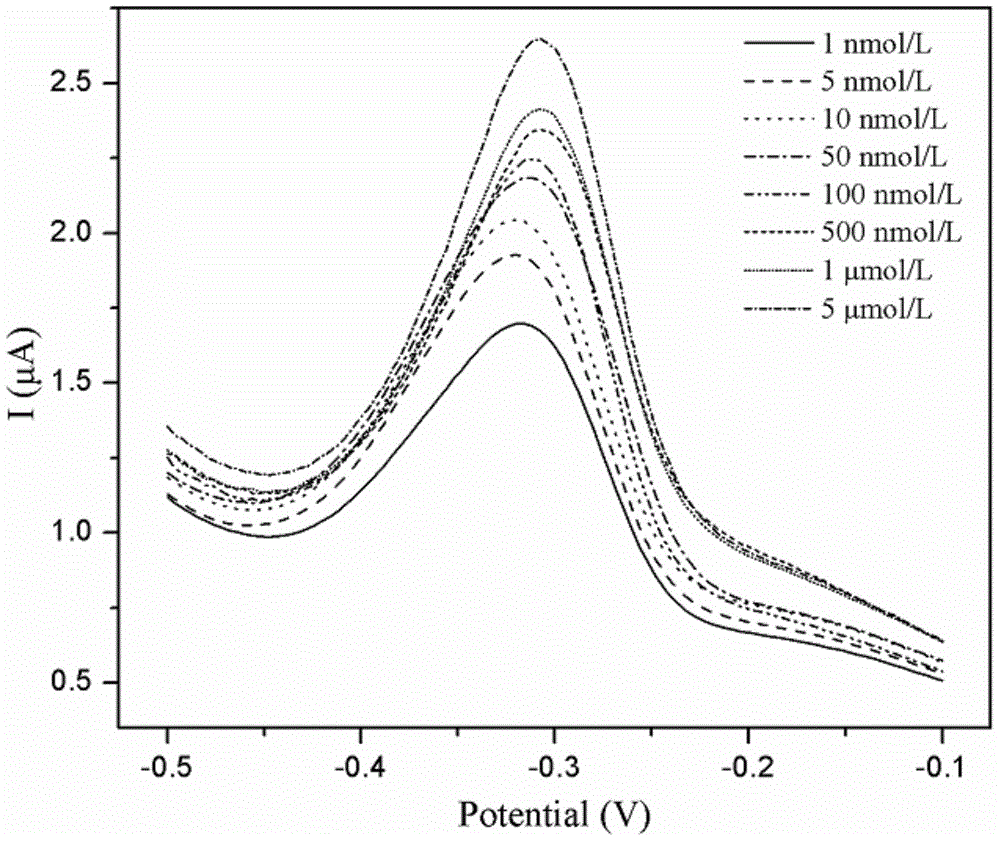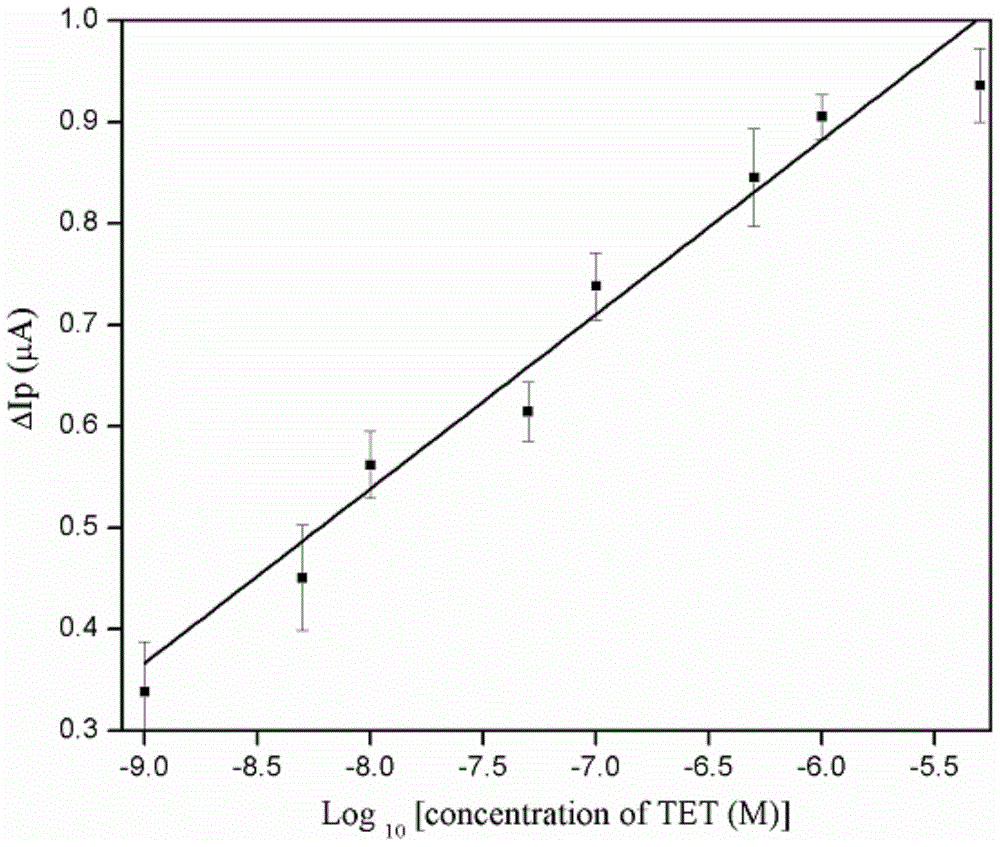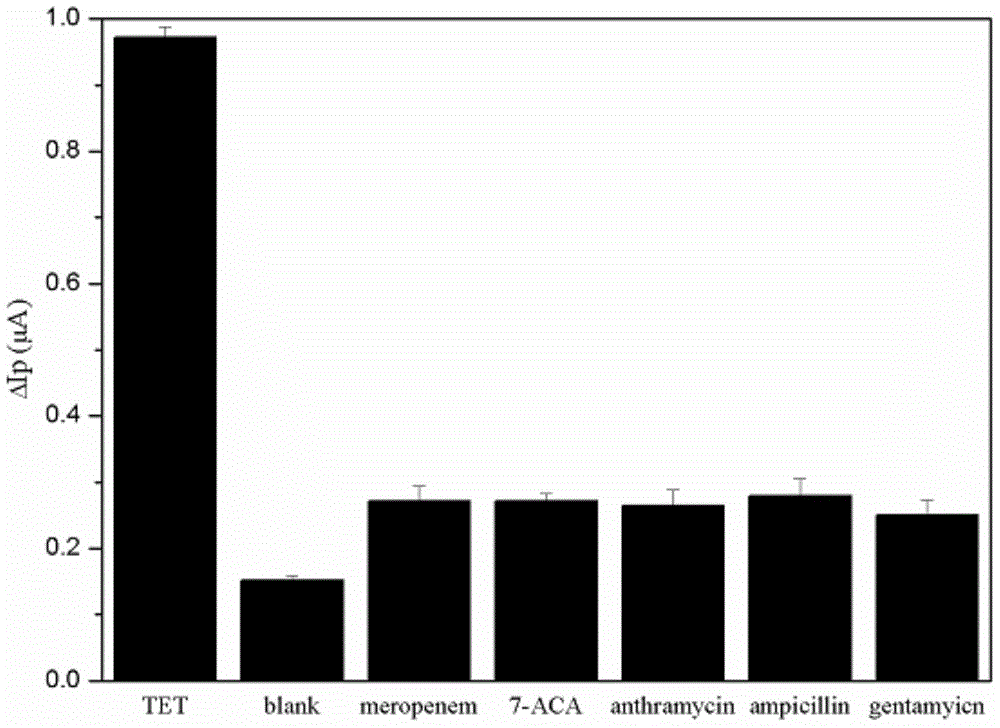Biological sensor for detecting tetracycline on basis of aptamer specificity and preparation method of biological sensor
A technology of biosensor and nucleic acid aptamer, which is applied in the field of biosensor and its preparation based on the specific detection of tetracycline based on nucleic acid aptamer, can solve the problems of difficulty in ensuring electrode uniformity, time-consuming and labor-intensive, etc., and achieve the goal of promoting electron transfer, catalysis The effect of high activity and good signal amplification
- Summary
- Abstract
- Description
- Claims
- Application Information
AI Technical Summary
Problems solved by technology
Method used
Image
Examples
Embodiment 1
[0040] This embodiment includes the following steps:
[0041] 1) Ultrasonic dispersion of 3.75 mg of ferric oxide / reduced graphene oxide in 10 mL of 2.0 mg / mL sodium alginate aqueous solution to obtain a uniform composite of ferric oxide / reduced graphene oxide-sodium alginate;
[0042] 2) 3 μL of ferric oxide / reduced graphene oxide‐sodium alginate complex was modified onto the surface of the working electrode, and dried at room temperature to form a film;
[0043]3) Coat 3 μL of tetracycline aptamer with a concentration of 5.0 μmol / L [sequence 5′‐CGTACGGAATTCGCTAGCCCCCCGGCAGGCCACGGCTTGGGTTGGTCCCACTGCGCGTGGATCCGAGCTCCACGTG‐3′(76‐mer)] on the surface modified with ferric oxide / reduced graphene oxide‐sodium alginate The surface of the composite working electrode was dried to form a film at room temperature and cleaned.
Embodiment 2
[0045] The nucleic acid aptamer sensor obtained in Example 1 is used for the detection of tetracycline, and the steps are as follows:
[0046] 1) Incubate the obtained electrode in different concentrations of tetracycline to be detected (1nmol / L, 5nmol / L, 10nmol / L, 50nmol / L, 100nmol / L, 500nmol / L, 1μmol / L, 5μmol / L) for 50min, and cleaning;
[0047] 2) A tetracycline nucleic acid aptamer-modified electrode was used as a working electrode, a carbon electrode was used as a counter electrode, and an Ag / AgCl electrode was used as a reference electrode to form a three-electrode system. 0 acetate buffer, using differential pulse voltammetry to detect changes in electrochemical signals before and after tetracycline incubation, the potential was set from –0.5V to –0.1V, the pulse width was 0.05V, and the scan rate was 0.5s;
[0048] 3) The differential pulse voltammetry response curves of different concentrations of tetracycline are plotted, and a standard curve is drawn according to t...
Embodiment 3
[0050] The nucleic acid aptamer sensor obtained in Example 1 is used for the detection of tetracycline and other antibiotics, and the steps are as follows:
[0051] 1) Incubate the obtained electrodes in different antibiotic solutions to be tested for 50 min, in which the concentration of tetracycline is 500 nmol / L, meropenem, 7‐aminocephalosporanic acid (7‐ACA), anthramycin, Ampicillin (ampicillin) and gentamycin (gentamycin) concentrations were both 5 μmol / L, and the blank control was ultrapure water, which was washed after incubation;
[0052] 2) A tetracycline nucleic acid aptamer-modified electrode was used as a working electrode, a carbon electrode was used as a counter electrode, and an Ag / AgCl electrode was used as a reference electrode to form a three-electrode system. In 0 acetate buffer, differential pulse voltammetry was used to detect the change of the electrochemical signal before and after incubation of the nucleic acid aptamer sensor. The potential was set from...
PUM
 Login to View More
Login to View More Abstract
Description
Claims
Application Information
 Login to View More
Login to View More - R&D
- Intellectual Property
- Life Sciences
- Materials
- Tech Scout
- Unparalleled Data Quality
- Higher Quality Content
- 60% Fewer Hallucinations
Browse by: Latest US Patents, China's latest patents, Technical Efficacy Thesaurus, Application Domain, Technology Topic, Popular Technical Reports.
© 2025 PatSnap. All rights reserved.Legal|Privacy policy|Modern Slavery Act Transparency Statement|Sitemap|About US| Contact US: help@patsnap.com



